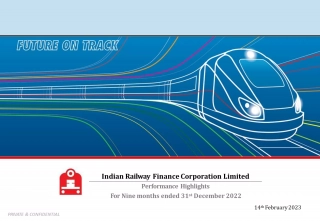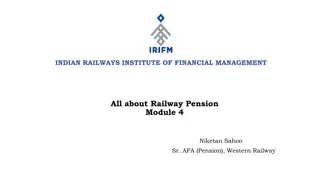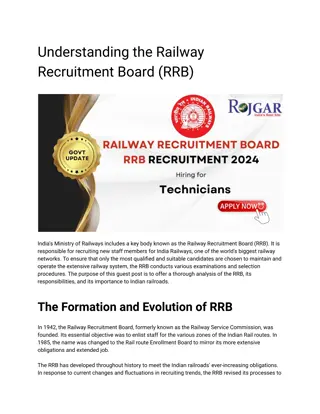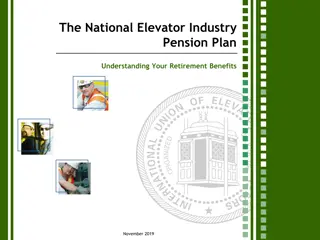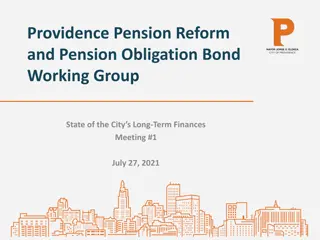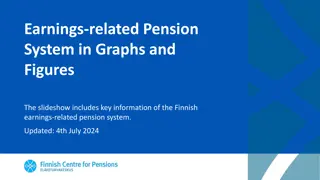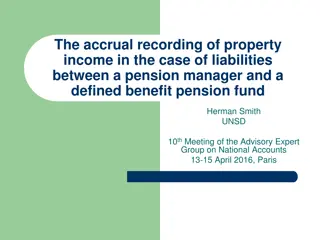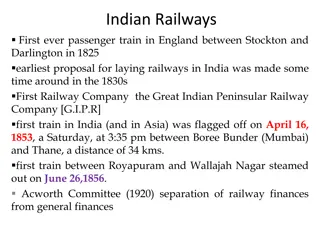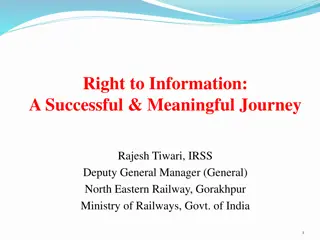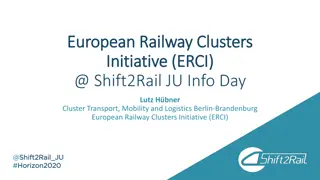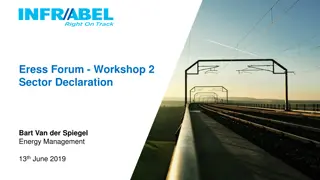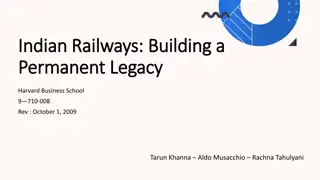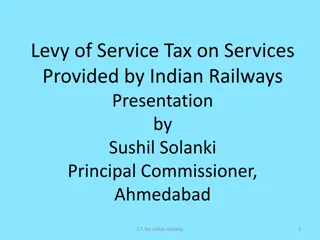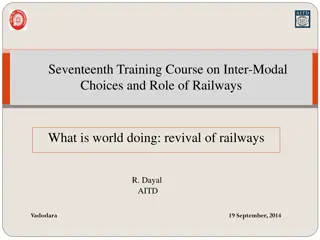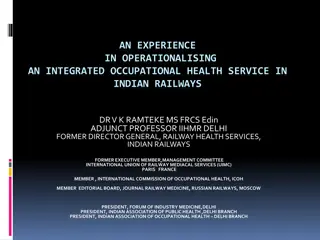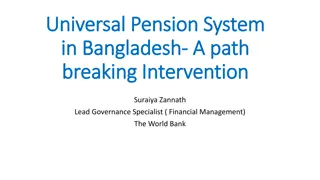Understanding Railway Pension System in Indian Railways
The Indian Railways Institute of Financial Management provides insights into the railway pension system, covering contributory and non-contributory pension schemes. Indian Railway employees enjoy benefits similar to Central Government employees, with pensions managed under specific rules and regulations. The pension scheme for Indian Railways is crucial for ensuring financial security for employees post-retirement. Learn about the commercial nature of Indian Railways, its pension fund, and key statistics regarding railway pensioners.
Download Presentation

Please find below an Image/Link to download the presentation.
The content on the website is provided AS IS for your information and personal use only. It may not be sold, licensed, or shared on other websites without obtaining consent from the author. Download presentation by click this link. If you encounter any issues during the download, it is possible that the publisher has removed the file from their server.
E N D
Presentation Transcript
INDIAN RAILWAYS INSTITUTE OF FINANCIAL MANAGEMENT All about Railway Pension Module 1 Niketan Sahoo Sr. AFA (Pension), Western Railway
What is pension? The word Pensioncomesfrom pensi , Latin for payment. It is a fund into which a sum of money is added periodically during an employee's employment years. Payments are then drawn from the fund periodically to support the employee s financial security after the employee s retirement from work. Pension can be Contributory or Non-Contributory one. Let us see what kinds of pension are out there: 2
What kind of pension applies to Indian Railways? Indian Railway employees are Central Government Employees. They enjoy benefits of wages and pension at par with Central Government employees and pensioners. Railway Pension is governed by Railway Service (Pension) Rule which comprises CCS (Pension) Rules and Orders issued by the Department of Pension & Pensioners welfare (DOP&PW) as well as Railway Board from time to time. But for employees inducted into rail service post 2004 who fall under NPS, pension scheme concerning majority railway employees in Indian Railways is largely non-contributoryin nature. 4
Pension in Indian Railways Indian Railways (IR) are a Commercial Organization. They earn revenue by selling transport services. IR s finances are based on an accounting system which complies with Government as well as Commercial Accounting norms. Drawing from the Going Concern concept, being a commercial organization, IR meets all its expenditure from the revenue it earns. IR s staff cost and pension liability are thus met out of the revenue it receives (Net Traffic Receipt). Being a commercial undertaking, IR created a Pension Fund to meet its future pension liability. The concept of Fund is now obsolete as IR is barely able to bear the huge incremental burden of pension pay-outs. In fact, IR is required to contribute annually to its Pension Fund an actuarially estimated amount. Why? So that the balance in the fund accurately reflects the amount paid in a given year as well as potential cumulative liability for employees pension benefits earned for each year of service rendered by them. 5
Railway Pension: important statistics Number of pensioners on 31/03/2020 15,30,000 **Postal/Treasury pensioners are legacy pensioners from 1970s and 80s after which pension is paid only through banks BANK WISE PENSIONERS Bank wise pensioners OTHER PSBs PSB Pensioners Market Share % 47% 53% State Bank of India 7,00,000 47% SBI Other PSBs 7,90,000 53% 6
Statistics continued PENSIONERS vs FAMILY PENSIONERS 41% 59% age range number of pensioners % <60 years 1,50,000 10% PENSIONERS FAMILY PENSIONERS 60-75 years 9,20,000 60% 75-80 years 3,50,000 20% 80-85 years 6% 1,01,000 Important trends 85-90 years 40,000 3% Average annual retirements : 50,000 Average closure of pension cases : 30,000 90-95 years 12,000 Net addition per annum : 20,000 1% 95-100 years 3,000 7
Impact of pension liability on IR : a budgetary overview rupees in crores w/o pension scenario Sr. Particulars 2014-2015 2019-2020 Increase % increase 1 Gross Traffic Receipt 1,59,248 2,16,675 57427 33% 2 Miscellaneous Receipts 4202 260 3 Total Receipts 1,63,450 2,16,935 53485 33% 4 Net Ordinary Working Expenses 1,08,970 1,55,000 46,030 42% 1,55,000 5 Appropriation to Pension Fund 29,225 50,000 20,775 71% 0 6 Appropriation to DRF 7775 500 500 7 Total Working Expenses (4+5+6) 1,45,970 205500 59530 41% 155500 8 Miscellaneous Expenditure 1028 2400 9 Total Expenditure (7+8) 1,46,998 60902 41% 207900 157900 10 Net Revenue (3-9) 7278 9035 - - 11 Appropriation to DF 1306 1000 - - 12 Appropriation to Capital Fund 5919 3035 - - 13 Appropriation to Railway Safety Fund 0 0 - - 14 Appropriation To Rail Suraksha Kosh 0 5000 - - 15 OPERATING RATIO 92% 95% - - 72% 8
IRs pension outgo since a decade 60000 Rupees in crores 50000 50000 47500 45797 44280 40000 42500 34500 7th CPC impact 29225 30000 24850 20710 20000 17105 10000 0 2011-2012 2012-2013 2013-2014 2014-2015 2015-2016 2016-2017 2017-2018 2018-2019 2019-2020 2020-2021
Railway Pension : future liability uncertainties and challenges Railway employees governed under old pension scheme are 11 lakh in number. Tentatively, the last pre-2004 batch is likely to retire by 2040. Annual pension outgo trend should then start on descending path. Old pension scheme retirees are set to be added gradually to existing pensioners tally. Even this gradual addition is going to inflate railways pension outgo sharply in coming years. Why? Due to addition of new pensioners, Due to increase in Dearness Relief (twice a year) Due to more pensioners entering 80 plus age group with increase in life expectancy; deceased pensioners count to about 60% of new pensioners being added annually Due to death cases of employees under NPS being covered under Old Pension Scheme Due to family pension benefits having been extended to unmarried/widow/divorced daughters over 25 years old. 10
Trends in IRs pension outgo : a hypothetical analysis Growth in number of pensioners vis-a-vis forecasted liability 25 20 21.1 L 20.8 L 20.5 L 19.8 L 18.3 L 16.8 L 15 15.3 L 1,45,000 CR 1,40,000 CR 1,15,000 CR 1,50,000 CR 90,000 CR 47,500 CR 68,000 CR 10 5 0 2020 2025 2030 2035 2040 2045 2050 This does not include impact of 8th & 9th PCs, if those should be there. 11
Railway Pension and the Operating Ratio Zonal Railways are profit centers of which both earnings and revenue expenses are accounted for zone wise. Railways Operating Ratio is worked out for each Zonal Railway as also for IR as a whole. A Zonal Railway s total working expense also include the total pensionary expenditure incurred by the Railway. Any significant increase in pension outgo without corresponding increase in earning has a reciprocal effect on the Operating Ratio. Due to rapidly increasing pension expenditure despite growth in reveues, and the resultant higher OR, each passing year leaves less than adequate surplus for IR s infrastructural development . Capacity enhancement and optimisation of resources needs assistance by way of deceleration of pensionary outgo. This warrants effective control and time bound reforms. 12
How IRs pension liability may be controlled Pension on IR can neither be scrapped nor dispensed with. However, steps that will aid improvement are: Sharing of IR s pension liability with the Central Government Sanitization of legacy data to weed out ghost pensioners. Critical review of Dependent Family Pension and Old Age Pension cases. Extensive Spot Checks of pension payment in banks, other disbursing units Accrual Accounting Streamlining the process including debit scrolls reconciliation and deployment of robust end-to-end application. Watching of recoveries from banks. Linking of Pension Accounts with Adhaar details (at par with DBT scheme). Rationalisation of jurisdiction of designated FA&CAOs in view of Core Banking System. Periodic review of pensioners status through KYP (Know your Pensioner) similar to banks KYC. 13
How Accrual Accounting will help : Understanding potential cumulative liability for pension benefits earned for railway employees for each year of service, not just the present actual liability. How strengthening Internal Audit (as per Finance Code1) will help : Timely and correct verification of service sheet, promotion, increment, recoveries, deduction, leave record will lead to accurate calculation of Qualifying Service, avoiding any possibility of overpayment. How a robust application will help : Exhaustive and correct mapping of processes will enable total automation and eliminate need for manual intervention in calculation of QS. How sanitizing legacy data will help : More than 50,000 PPOs exist for which debits are received by Railways but no railway is able to take ownership of these PPOs. Genuineness of all such PPOs needs urgent verification. 14
How Spot Checks will help : IR s in-house debit reconciliation may not provide 100% accuracy because pension payouts are regulated by externalities such as Life Certificate and its genuineness, marriage/divorce status/nonemployment status of dependents, availability of bonafide physical documents at bank s end, so forth. These subjective factors can best be verified through spot checks. At present banks are disbursing addition quantum of Pension/Family pension to more than 1.5 lakh railway pensioners aged 80 years and above . This number is rising rapidly. Age profile of these senior pensioners can best be verified through spot-checks including using video connect. It may not be practically possible to cover each payment making bank outlet. However, checking 100% pensioners in one specific branch and carrying out varying percentage checks in other branches will minimize scope for misrepresentation of pensioners details. 15
How watching bank recoveries will help : Instances of overpayment of pension by banks do happen. Recovery of overpayment by bank and remittance of recovery in installments needs to be watched with similar care as adopted by banks in cases of recovery of loans extended by banks to their customers. How strengthening mechanism of Reconciliation of debit scrolls helps : Although reconciliation of pension debit scrolls has been automated, it is still not foolproof because legacy data has not been sanitized nor hundred percent revision of PPOs achieved yet. 16
How PFA wise rationalization of jurisdiction will help : The extant stipulated jurisdiction of designated FA&CAOs does not give uniformity among railways with reference to their position as PPO issuing railway versus debit accepting railway. Railway number of PPOs issued as home rly number of debits assigned as designated FA&CAO States covered debit responsibility index (DRI) NER 60,000 6,000 Uttarakhand - 90% NCR 60,000 2,50,000 Uttar Pradesh + 300% NR 1,60,000 80,000 Punjab, Haryana, Delhi, Himachal Pradesh, Jammu, Kashmir - 50% WR 1,35,000 75,000 Gujarat - 45% PUs 45,000 0 all over India - 100% Making each railway/PU liable for acceptance and settlement of pension debits against PPOs actually issued by the railway and not for PPOs issued by other units, especially as online/digital banking system is now the norm, may induce better awareness and responsibility towards this expenditure in the debit bearing railway.
Thank you 18




